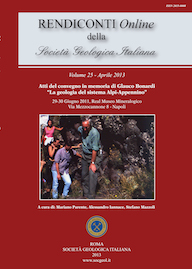
The stratigraphic record of the Alì-Montagnareale Unit (Peloritani Mountains, NE Sicily, Italy)
Roberta Somma (*), Ivan Martin-Rojas (**) & Vincenzo Perrone (°)
(*) Dipartimento di Scienze degli Alimenti e dell'Ambiente, Università degli Studi di Messina, Sant'Agata, 98166 Messina, Italy. E-mail: rsomma@unime.it
(**) Departamento de Ciencias de la Tierra y del Medio Ambiente, Universidad de Alicante, Ap. 99 03080 Alicante, Spain.
(°) Dipartimento di Scienze della Terra, della Vita e dell'Ambiente, Università di Urbino, Campus Scientifico "Enrico Mattei", Località Crocicchia, 61029 Urbino, Italy.
Volume: 25/2013
Pages: 106-115
Abstract
Some Internal Units of the western Alpine peri-Mediterranean orogenic system (Betic Cordillera, Calabria-Peloritani Arc) point out to a complex Alpine tectono-metamorphic evolution followed by an exhumation phase. Before the onset of the Alpine compressive tectonics, the rocks of these units belonged to the margins of a microcontinent, the Mesomediterranean Microplate, originated, together with the main plates, following the break-up of Pangaea. To these units, characterized by similar tectono-sedimentary evolution, belongs the Alì-Montagnareale Unit of the Peloritani Mountains (NE Sicily), where the Internal Units of the Sicilian sector of the Maghrebian Chain crop out. The Alì-Montagnareale Unit appears within two small tectonic semi-windows, under the phyllites of the Mandanici-Piraino Unit, and it proves to be formed by three groups of anchimetamorphic formations.
The Lower Group is made up of two Upper Permian?-Upper Triassic siliciclastic formations, which grade into each other and which were deposited in alluvial environments. This group is followed by the Intermediate Group, consisting of Middle?-Upper? Triassic formations, indicating deposition in an evaporitic coastal plain evolving to a marine carbonate platform. The Upper Group consists of a Pliensbachian formation, made up of pelagic calcilutites with added carbonate turbiditic beds, followed by a prevailingly marly formation with strata of silicified limestones and episodic calcareous re-sediments. In this latter formation, the finding of Jurassic fossils and Globuligerina oxfordiana, which occurs up to the Valanginian, indicate that the stratigraphic succession spans from the late Early Jurassic to the Late Jurassic and probably reaches the Early Cretaceous.
The stratigraphic units are generally separated by tectonic contacts which act as preferential detachment surfaces during compressive and exhumation tectonic phases. The tectonic elision of more or less large intervals of the original stratigraphic succession is diffuse in both tectonic windows.
The succession of the Alì-Montagnareale Unit testifies to extensional tectonics, which in Middle-Late Triassic determined the evolution of sedimentation from continental to evaporitic and neritic environments, and, since the Early Jurassic, to calcilutite and marly pelagic sediments with added calcareous re-sediments. This sedimentary evolution records the break-up of Pangaea and the successive opening of oceanic basins. A similar tectono-sedimentary history may be recognized in many other Internal Units of the Alpine peri-Mediterranean Chains.
Keywords
Get Full Text